Day-Ahead Optimal Scheduling of an Integrated Energy System Based on a Piecewise Self-Adaptive Particle Swarm Optimization Algorithm
Abstract
:1. Introduction
2. Electric–Natural Gas IES Considering New Structural EH
2.1. EH Model
2.2. Modeling of Coupling Components
2.2.1. Power to Gas (P2G) System
2.2.2. Co-Generation Model of the Fuel Cell (FC)
2.2.3. Hydrogen Storage Tank (HST)
2.3. Modeling of Power System
2.3.1. Electric Network
2.3.2. Battery Storage System (BSS)
2.4. Modeling of Natural Gas System
2.5. Energy Conversion Relationship of the Proposed EH
3. PCAPSO Algorithm for the Optimal Scheduling of IES
3.1. System Constraints
3.1.1. Power System Constraints
3.1.2. Natural Gas System Constraints
3.1.3. Battery Storage System (BSS) Constraints
3.1.4. Hydrogen Storage Tank (HST) Constraints
3.2. PCASO Optimization Model and Algorithm
3.2.1. Objective Function
3.2.2. Optimization Algorithm
4. Case Study
4.1. System Description
4.2. Effectiveness of OEF Using PCAPSO Based on Chaotic Mapping
4.3. Operation Characteristics and Economic Analysis of IES in Different Scenarios
5. Conclusions
- (1)
- Developing a new efficient PCAPSO algorithm based on multistage chaotic mapping.
- (2)
- Integrating detailed models of FC and P2G into the EH to form a novel framework of the EH, in which the joint operation of the FC, P2G system, and HST is considered and hydrogen is introduced.
- (3)
- Establishing a new scheduling strategy to reduce the operation cost of IES. In this strategy, when the electric load is light, P2H and HST cooperate to absorb excess wind/solar energy and transform it into hydrogen, which can then be used as the starting material for the H2G process to synthesize natural gas. When the electric load is heavy, hydrogen transformed from the P2H process or stored in the HST can be used as the fuel in the FC to generate electricity.
- (1)
- The PCAPSO based on piecewise-chaotic mapping is less likely to fall into local optima than PSO. In addition, the stability and convergence rate of PCAPSO are better than those of PSO.
- (2)
- The FC cooperating with the HST and P2H system is capable of peak load shifting when operated as a co-generation device, and its operation cost can be compensated by selling heat.
- (3)
- The integration of the BSS and FC into the IES can increase the consumption rate of renewable energy and decrease the amount of electricity drawn from the upstream grid.
- (4)
Author Contributions
Funding
Data Availability Statement
Conflicts of Interest
References
- Hoseinzadeh, S.; Ghasemi, M.H.; Heyns, S. Application of Hybrid Systems in Solution of Low Power Generation at Hot Seasons for Micro Hydro Systems. Renew. Energy 2020, 160, 323–332. [Google Scholar] [CrossRef]
- Tomin, N.; Shakirov, V.; Kozlov, A.; Sidorov, D.; Kurbatsky, V.; Rehtanz, C.; Lora, E.E.S. Design and Optimal Energy Management of Community Microgrids with Flexible Renewable Energy Sources. Renew. Energy 2022, 183, 903–921. [Google Scholar] [CrossRef]
- Sun, Y.; Zhang, B.; Ge, L.; Sidorov, D.; Wang, J.; Xu, Z. Day-Ahead Optimization Schedule for Gas-Electric Integrated Energy System Based on Second-Order Cone Programming. CSEE J. Power Energy Syst. 2020, 6, 142–151. [Google Scholar] [CrossRef]
- Ghasemi, A.; Banejad, M.; Rahimiyan, M. Integrated Energy Scheduling under Uncertainty in a Micro Energy Grid. Transm. Distrib. IET Gener. 2018, 12, 2887–2896. [Google Scholar] [CrossRef]
- Zhang, Y.; Wang, X.; He, J.; Xu, Y.; Pei, W. Optimization of Distributed Integrated Multi-Energy System Considering Industrial Process Based on Energy Hub. J. Mod. Power Syst. Clean Energy 2020, 8, 863–873. [Google Scholar] [CrossRef]
- Zhou, B.; Xu, D.; Li, C.; Chung, C.Y.; Cao, Y.; Chan, K.W.; Wu, Q. Optimal Scheduling of Biogas–Solar–Wind Renewable Portfolio for Multicarrier Energy Supplies. IEEE Trans. Power Syst. 2018, 33, 6229–6239. [Google Scholar] [CrossRef] [Green Version]
- Chen, C.; Liu, S.; Lin, Z.; Yang, L.; Wu, X.; Qiu, W.; Gao, Q.; Zhu, T.; Xing, F.; Zhang, J. Optimal Coordinative Operation Strategy of the Electric–Thermal–Gas Integrated Energy System Considering CSP Plant. IET Energy Syst. Integr. 2020, 2, 187–195. [Google Scholar] [CrossRef]
- Xu, D.; Zhou, B.; Wu, Q.; Chung, C.Y.; Li, C.; Huang, S.; Chen, S. Integrated Modelling and Enhanced Utilization of Power-to-Ammonia for High Renewable Penetrated Multi-Energy Systems. IEEE Trans. Power Syst. 2020, 35, 4769–4780. [Google Scholar] [CrossRef]
- Li, P.; Sheng, W.; Duan, Q.; Li, Z.; Zhu, C.; Zhang, X. A Lyapunov Optimization-Based Energy Management Strategy for Energy Hub With Energy Router. IEEE Trans. Smart Grid 2020, 11, 4860–4870. [Google Scholar] [CrossRef]
- Ju, L.; Zhao, R.; Tan, Q.; Lu, Y.; Tan, Q.; Wang, W. A Multi-Objective Robust Scheduling Model and Solution Algorithm for a Novel Virtual Power Plant Connected with Power-to-Gas and Gas Storage Tank Considering Uncertainty and Demand Response. Appl. Energy 2019, 250, 1336–1355. [Google Scholar] [CrossRef]
- Geng, S.; Vrakopoulou, M.; Hiskens, I.A. Optimal Capacity Design and Operation of Energy Hub Systems. Proc. IEEE 2020, 108, 1475–1495. [Google Scholar] [CrossRef]
- Shao, C.; Wang, X.; Shahidehpour, M.; Wang, X.; Wang, B. An MILP-Based Optimal Power Flow in Multicarrier Energy Systems. IEEE Trans. Sustain. Energy 2017, 8, 239–248. [Google Scholar] [CrossRef]
- Li, C.; Yang, H.; Shahidehpour, M.; Xu, Z.; Zhou, B.; Cao, Y.; Zeng, L. Optimal Planning of Islanded Integrated Energy System With Solar-Biogas Energy Supply. IEEE Trans. Sustain. Energy 2020, 11, 2437–2448. [Google Scholar] [CrossRef]
- Yang, W.; Liu, W.; Chung, C.Y.; Wen, F. Coordinated Planning Strategy for Integrated Energy Systems in a District Energy Sector. IEEE Trans. Sustain. Energy 2020, 11, 1807–1819. [Google Scholar] [CrossRef]
- Wang, C.; Wei, W.; Wang, J.; Bai, L.; Liang, Y.; Bi, T. Convex Optimization Based Distributed Optimal Gas-Power Flow Calculation. IEEE Trans. Sustain. Energy 2018, 9, 1145–1156. [Google Scholar] [CrossRef]
- Wang, Y.; Wang, Y.; Huang, Y.; Yu, H.; Du, R.; Zhang, F.; Zhang, F.; Zhu, J. Optimal Scheduling of the Regional Integrated Energy System Considering Economy and Environment. IEEE Trans. Sustain. Energy 2019, 10, 1939–1949. [Google Scholar] [CrossRef]
- Eladl, A.A.; El-Afifi, M.I.; Saeed, M.A.; El-Saadawi, M.M. Optimal Operation of Energy Hubs Integrated with Renewable Energy Sources and Storage Devices Considering CO2 Emissions. Int. J. Electr. Power Energy Syst. 2020, 117, 105719. [Google Scholar] [CrossRef]
- Chen, Y.; Wang, Y.; Ma, J. Multi-Objective Optimal Energy Management for the Integrated Electrical and Natural Gas Network with Combined Cooling, Heat and Power Plants. Energies 2018, 11, 734. [Google Scholar] [CrossRef] [Green Version]
- Keihan Asl, D.; Seifi, A.R.; Rastegar, M.; Mohammadi, M. Optimal Energy Flow in Integrated Energy Distribution Systems Considering Unbalanced Operation of Power Distribution Systems. Int. J. Electr. Power Energy Syst. 2020, 121, 106132. [Google Scholar] [CrossRef]
- Shabanpour-Haghighi, A.; Seifi, A.R. Energy Flow Optimization in Multicarrier Systems. IEEE Trans. Ind. Inf. 2015, 11, 1067–1077. [Google Scholar] [CrossRef]
- Massrur, H.R.; Niknam, T.; Fotuhi-Firuzabad, M. Day-Ahead Energy Management Framework for a Networked Gas–Heat–Electricity Microgrid. Transm. Distrib. IET Gener. 2019, 13, 4617–4629. [Google Scholar] [CrossRef]
- Tan, Y.; Wang, X.; Zheng, Y. A New Modeling and Solution Method for Optimal Energy Flow in Electricity-gas Integrated Energy System. Int. J. Energy Res. 2019, 43, 4322–4343. [Google Scholar] [CrossRef]
- Eberhart, R.; Kennedy, J. A New Optimizer Using Particle Swarm Theory. In Proceedings of the Sixth International Symposium on Micro Machine and Human Science, Nagoya, Japan, 4–6 October 1995; pp. 39–43. [Google Scholar]
- Wang, D.; Tan, D.; Liu, L. Particle Swarm Optimization Algorithm: An Overview. Soft Comput. 2018, 22, 387–408. [Google Scholar] [CrossRef]
- Liu, H.; Zhang, X.-W.; Tu, L.-P. A Modified Particle Swarm Optimization Using Adaptive Strategy. Expert Syst. Appl. 2020, 152, 113353. [Google Scholar] [CrossRef]
- Patwal, R.S.; Narang, N. Multi-Objective Generation Scheduling of Integrated Energy System Using Fuzzy Based Surrogate Worth Trade-off Approach. Renew. Energy 2020, 156, 864–882. [Google Scholar] [CrossRef]
- Mellouk, L.; Ghazi, M.; Aaroud, A.; Boulmalf, M.; Benhaddou, D.; Zine-Dine, K. Design and Energy Management Optimization for Hybrid Renewable Energy System- Case Study: Laayoune Region. Renew. Energy 2019, 139, 621–634. [Google Scholar] [CrossRef]
- Bao, Z.; Chen, D.; Wu, L.; Guo, X. Optimal Inter- and Intra-Hour Scheduling of Islanded Integrated-Energy System Considering Linepack of Gas Pipelines. Energy 2019, 171, 326–340. [Google Scholar] [CrossRef]
- Zou, Y.; Yang, G.; Zheng, H.; Yi, J.; Hu, R. Dispatching for Integrated Energy System Based on Improved Niche PSO Algorithm. Proc. CSU-EPSA 2020, 32, 47–52,60. [Google Scholar]
- Liu, X.; Wang, Q.; Wu, C. A Stackelberg Game Approach for Heterogeneous Energy Market in Integrated Energy System. Int. J. Energy Res. 2021, 45, 1038–1054. [Google Scholar] [CrossRef]
- Mirzaei, M.A.; Oskouei, M.Z.; Mohammadi-Ivatloo, B.; Loni, A.; Zare, K.; Marzband, M.; Shafiee, M. Integrated Energy Hub System Based on Power-to-Gas and Compressed Air Energy Storage Technologies in the Presence of Multiple Shiftable Loads. Transm. Distrib. IET Gener. 2020, 14, 2510–2519. [Google Scholar] [CrossRef]
- Chang, H.; Xu, X.; Shen, J.; Shu, S.; Tu, Z. Performance Analysis of a Micro-Combined Heating and Power System with PEM Fuel Cell as a Prime Mover for a Typical Household in North China. Int. J. Hydrogen Energy 2019, 44, 24965–24976. [Google Scholar] [CrossRef]
- Sui, Q.; Ma, X.; Wei, F.; Lin, X.; Guo, X.; Sun, J.; Li, Z. Day-ahead Dispatching Optimization Strategy for Energy Network Considering Fuel Cell Thermal-electric Comprehensive Utilization. Proc. Chin. Soc. Electr. Eng. 2019, 39, 1603–1613. [Google Scholar]
- Al-Baghdadi, M. Modelling of Proton Exchange Membrane Fuel Cell Performance Based on Semi-Empirical Equations. Renew. Energy 2005, 30, 1587–1599. [Google Scholar] [CrossRef]
- Chen, J.; Yu, Q.; Li, Q.; Lin, Z.; Li, C. Probabilistic Energy Flow Analysis of MCE System Considering Various Coupling Units and the Uncertainty of Distribution Generators. IEEE Access 2019, 7, 100394–100405. [Google Scholar] [CrossRef]
- Hoseinzadeh, S.; Stephan Heyns, P. Advanced Energy, Exergy, and Environmental (3E) Analyses and Optimization of a Coal-Fired 400 MW Thermal Power Plant. J. Energy Resour. Technol. 2021, 143, 082106. [Google Scholar] [CrossRef]
- Dou, C.; Mi, X.; Ma, K.; Xu, S. Coordinated Operation of Multi-Energy Microgrid with Flexible Load. J. Renew. Sustain. Energy 2019, 11, 054101. [Google Scholar] [CrossRef]
- Hussain, S.; Ahmed, M.A.; Kim, Y.-C. Efficient Power Management Algorithm Based on Fuzzy Logic Inference for Electric Vehicles Parking Lot. IEEE Access 2019, 7, 65467–65485. [Google Scholar] [CrossRef]
- Hussain, S.; Ahmed, M.A.; Lee, K.-B.; Kim, Y.-C. Fuzzy Logic Weight Based Charging Scheme for Optimal Distribution of Charging Power among Electric Vehicles in a Parking Lot. Energies 2020, 13, 3119. [Google Scholar] [CrossRef]
- Hussain, S.; Lee, K.-B.; Ahmed, M.A.; Hayes, B.; Kim, Y.-C. Two-Stage Fuzzy Logic Inference Algorithm for Maximizing the Quality of Performance under the Operational Constraints of Power Grid in Electric Vehicle Parking Lots. Energies 2020, 13, 4634. [Google Scholar] [CrossRef]

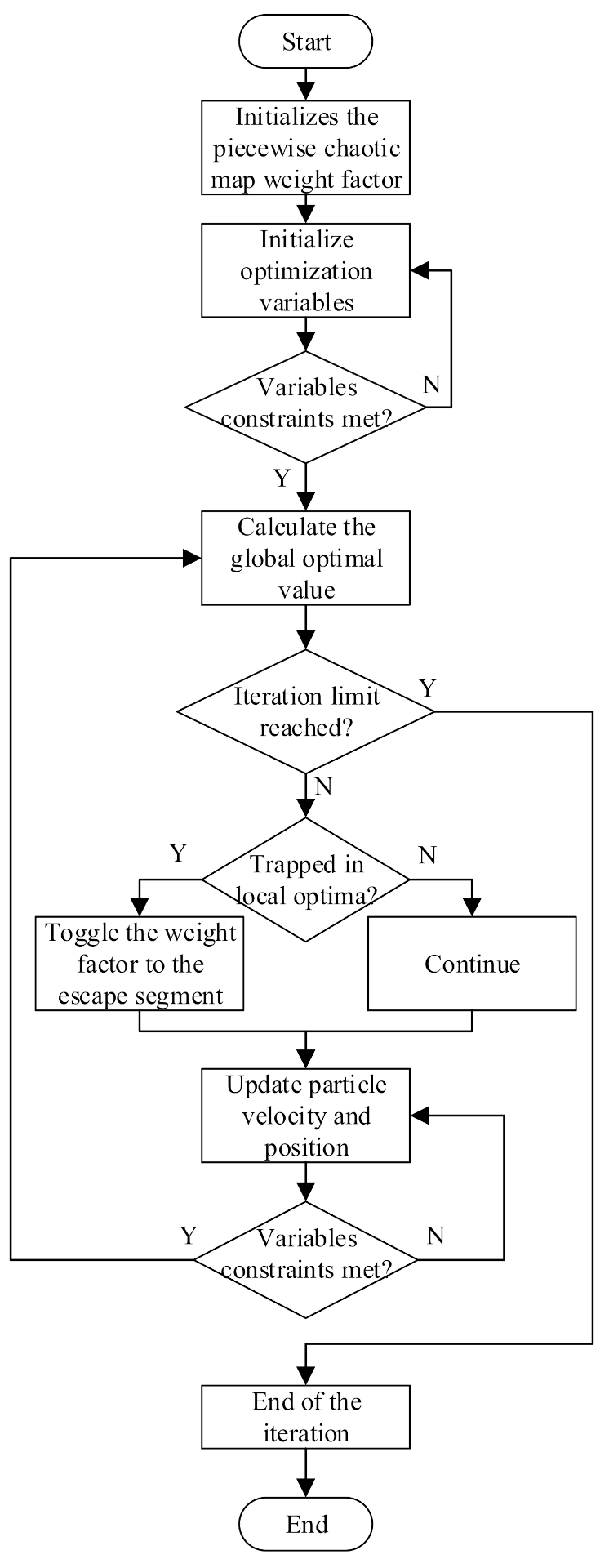
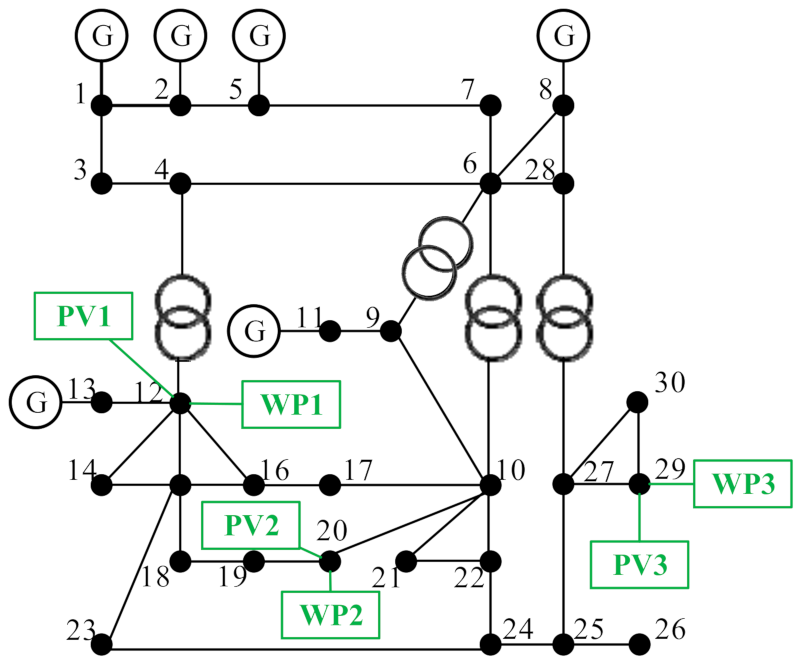
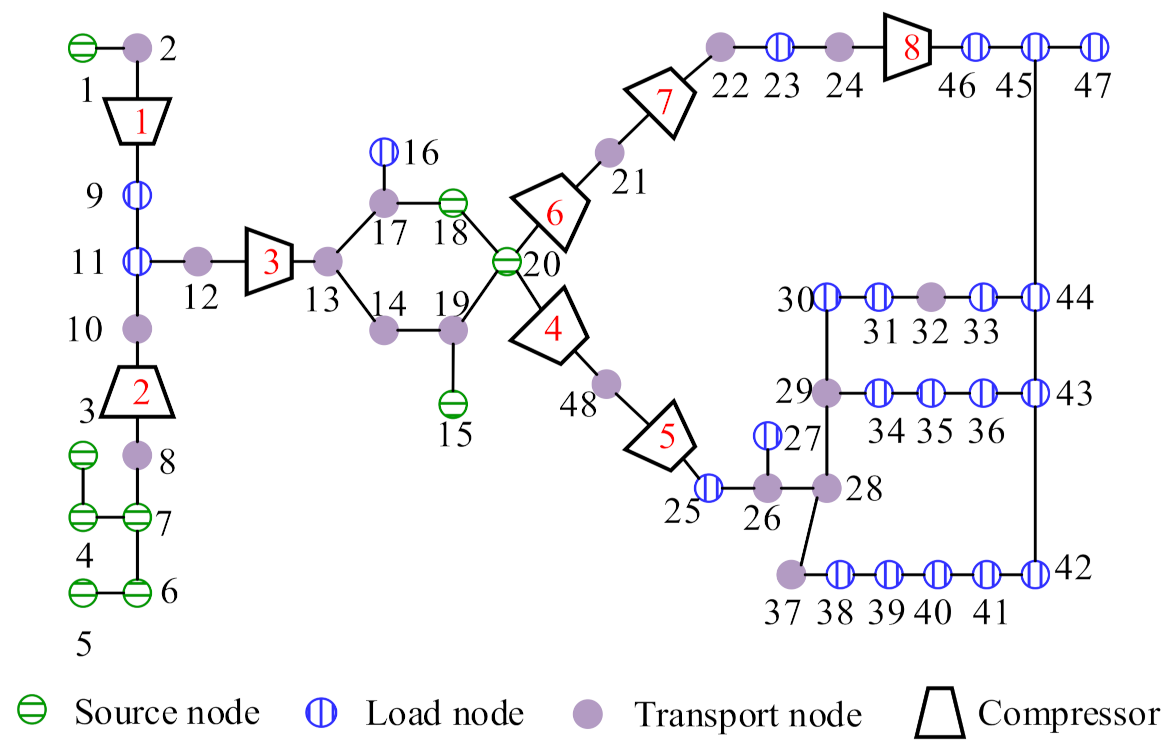
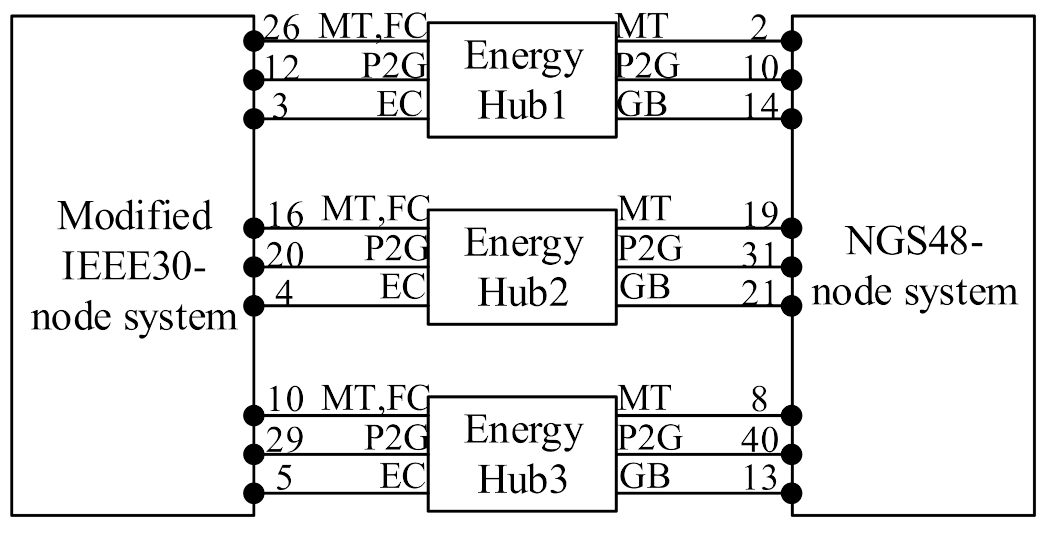
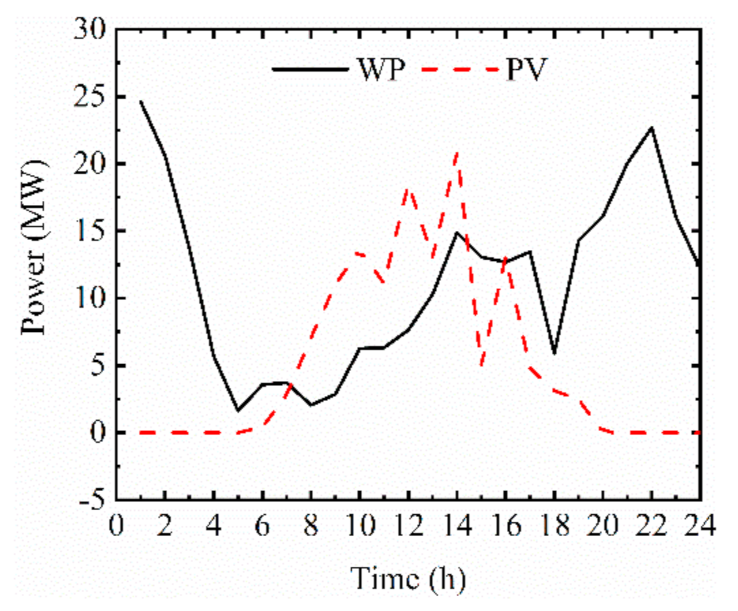
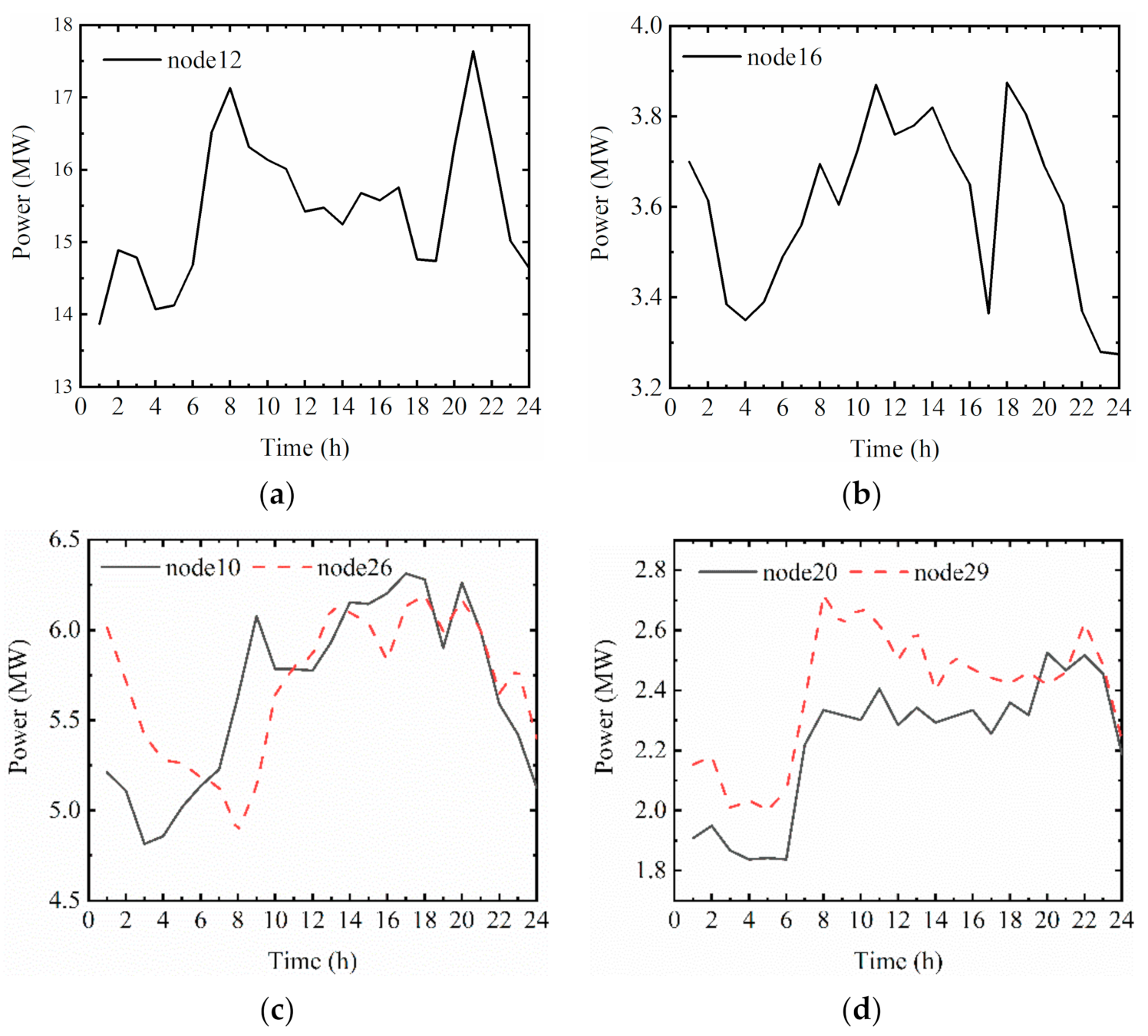
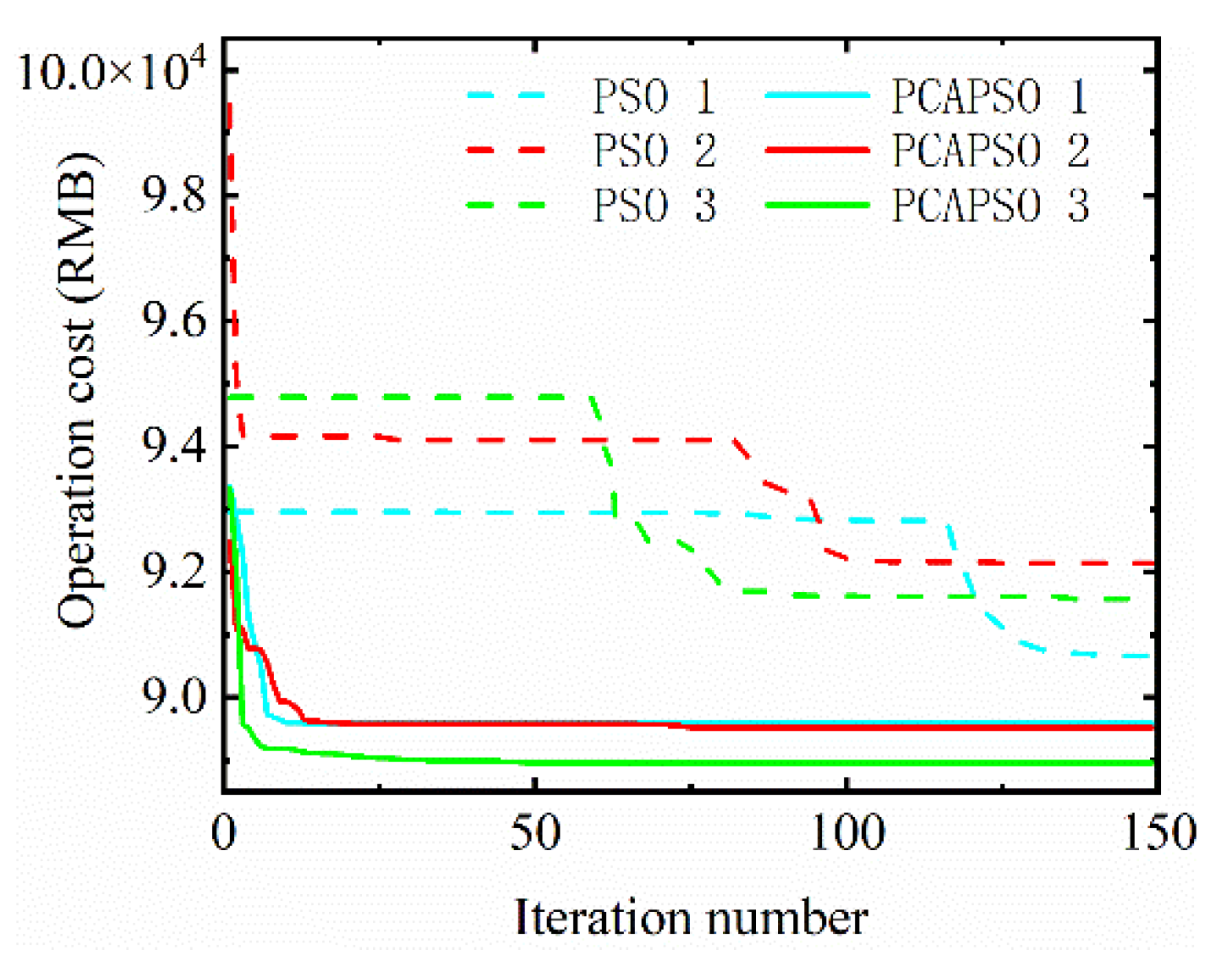
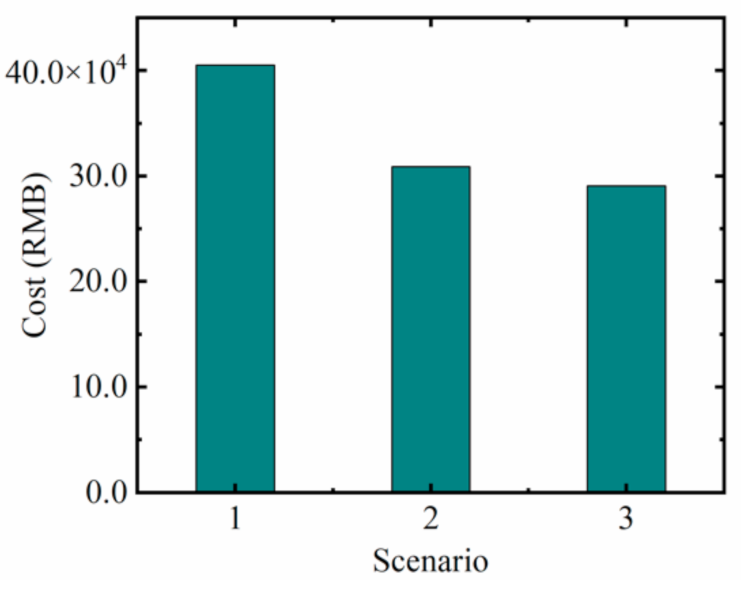
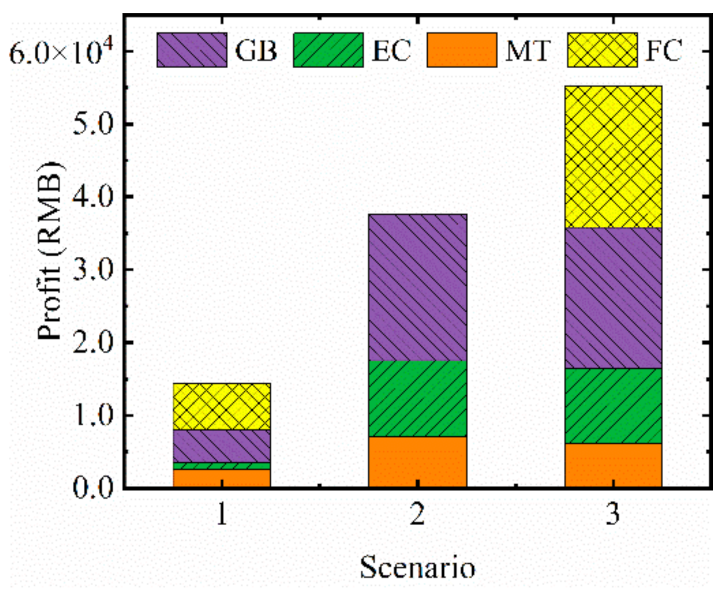

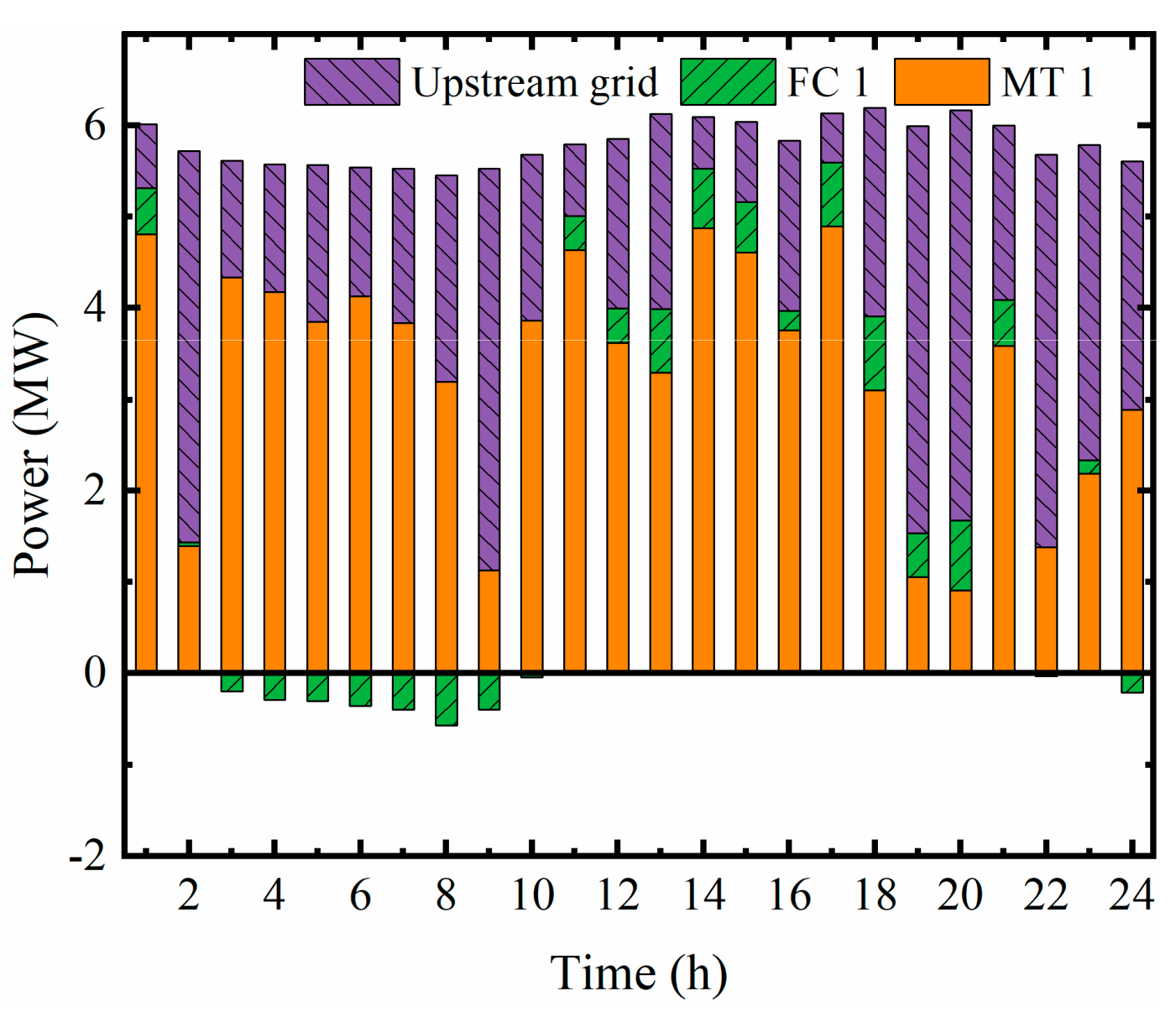



| Price Type | Peak Price/¥ | Normal Price/¥ | Valley Price/¥ | |
|---|---|---|---|---|
| Coefficient | ||||
| Electrical system | a(t) | 0.045 | 0.0375 | 0.03 |
| b(t) | 2.1 | 1.75 | 1.4 | |
| Natural gas system | Ccom(t) | 0.24 | 0.2 | 0.16 |
| Calculation Label | No.1/×103¥ | No.2/×103¥ | No.3/×103¥ | Average/×103¥ | Standard Deviation/×103¥ | |
|---|---|---|---|---|---|---|
| Algorithm | ||||||
| PCAPSO | 89.59 | 89.52 | 88.96 | 89.36 | 0.24 | |
| PSO | 90.67 | 92.14 | 91.56 | 91.46 | 0.52 | |
| Node 10 | Node 16 | Node 26 | |||||||
|---|---|---|---|---|---|---|---|---|---|
| Peak Load/MW | Valley Load/MW | Standard Deviation/MW | Peak Load/MW | Valley Load/MW | Standard Deviation/MW | Peak Load/MW | Valley Load/MW | Standard Deviation/MW | |
| Scenario 1 | 6.31 | 4.81 | 0.48 | 3.88 | 3.28 | 0.19 | 5.68 | 5.39 | 0.09 |
| Scenario 2 | 6.31 | 4.81 | 0.48 | 3.88 | 3.28 | 0.19 | 6.19 | 4.88 | 0.38 |
| Scenario 3 | 5.65 | 5.24 | 0.11 | 3.59 | 3.23 | 0.11 | 5.68 | 5.39 | 0.09 |
Publisher’s Note: MDPI stays neutral with regard to jurisdictional claims in published maps and institutional affiliations. |
© 2022 by the authors. Licensee MDPI, Basel, Switzerland. This article is an open access article distributed under the terms and conditions of the Creative Commons Attribution (CC BY) license (https://creativecommons.org/licenses/by/4.0/).
Share and Cite
Chen, J.; Ning, K.; Xin, X.; Shi, F.; Zhang, Q.; Li, C. Day-Ahead Optimal Scheduling of an Integrated Energy System Based on a Piecewise Self-Adaptive Particle Swarm Optimization Algorithm. Energies 2022, 15, 690. https://doi.org/10.3390/en15030690
Chen J, Ning K, Xin X, Shi F, Zhang Q, Li C. Day-Ahead Optimal Scheduling of an Integrated Energy System Based on a Piecewise Self-Adaptive Particle Swarm Optimization Algorithm. Energies. 2022; 15(3):690. https://doi.org/10.3390/en15030690
Chicago/Turabian StyleChen, Jiming, Ke Ning, Xingzhi Xin, Fuhao Shi, Qing Zhang, and Chaolin Li. 2022. "Day-Ahead Optimal Scheduling of an Integrated Energy System Based on a Piecewise Self-Adaptive Particle Swarm Optimization Algorithm" Energies 15, no. 3: 690. https://doi.org/10.3390/en15030690
APA StyleChen, J., Ning, K., Xin, X., Shi, F., Zhang, Q., & Li, C. (2022). Day-Ahead Optimal Scheduling of an Integrated Energy System Based on a Piecewise Self-Adaptive Particle Swarm Optimization Algorithm. Energies, 15(3), 690. https://doi.org/10.3390/en15030690






